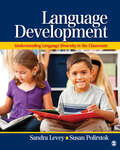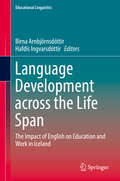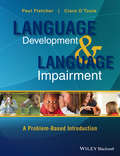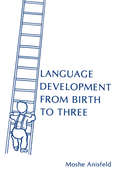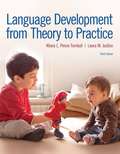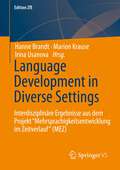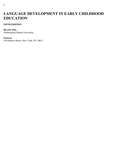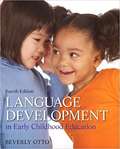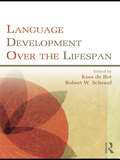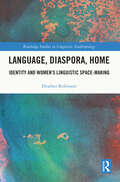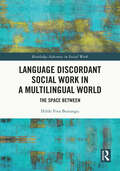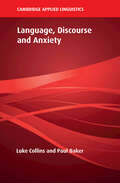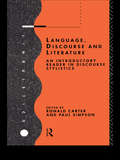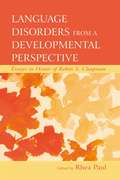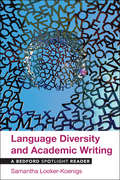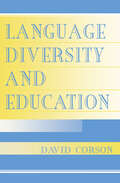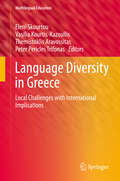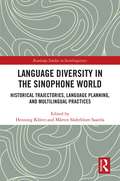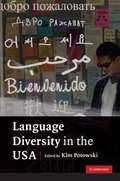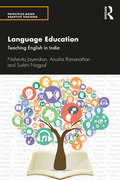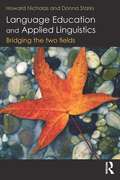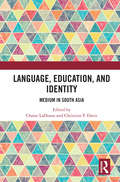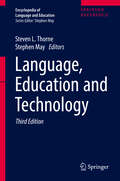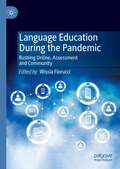- Table View
- List View
Language Development: Understanding Language Diversity in the Classroom
by Sandra Levey, Susan PolirstokPrepares future and current teachers to understand language development, differences, and disorders—and the factors that lead to classroom success Language Development: Understanding Language Diversity in the Classroom offers comprehensive coverage of the language development process for pre- and in-service teachers while emphasizing the factors that further academic success in the classroom, including literacy skills, phonological awareness, and narrative. With chapters written by respected specialists in various fields, this interdisciplinary text illuminates the impact of language development on learning success and distinguishes between language differences and disorders, integrating illustrative case studies as well as helpful classroom strategies that teachers can implement right away.
Language Development across the Life Span
by Birna Arnbjörnsdóttir Hafdís IngvarsdóttirThis book offers insights from a seven-year study into the impact of English as an International Language at a national level, from the effect of rich English input on a previously monolingual people’s linguistic repertoire to its effect on the situated language use demanded of speakers who find themselves in a new linguistic environment for which they have not been prepared. The changes described in the book have occurred in a speech community that identifies strongly with the local language, but finds itself increasingly having to use another language to perform daily functions in education and work. Findings describe how the official language and educational policies have not addressed this new linguistic ecology of Iceland. The findings of these studies have larger international practical, educational, empirical, and theoretical implications and should be relevant to anyone interested in in the impact of English as an International Language.
Language Development and Language Impairment
by Ciara O'Toole Paul FletcherLanguage Development and Language Impairment offers a problem-based introduction to the assessment and treatment of a wide variety of childhood language developmental disorders. Focuses for the most part on the pre-school years, the period during which the foundations for language development are laid Uses a problem-based approach, designed to motivate students to find the information they need to identify and explore learning issues that a particular speech or language issue raises Examines the development of a child's phonological system, the growth of vocabulary, the development of grammar, and issues related to conversational and narrative competence Integrates information on typical and atypical language development
Language Development From Birth To Three
by Moshe AnisfeldWith selections of philosophers from Plotinus to Bruno, this new anthology provides significant learning support and historical context for the readings along with a wide variety of pedagogical assists.Featuring biographical headnotes, reading introductions, study questions, as well as specialPrologues andPhilosophical Overviews, this anthology offers a unique set of critical thinking promtps to help students understand and appreciate the philosophical concepts under discussion.Philosophical Bridges discuss how the work of earlier thinkers would influence philosophers to come and place major movements in a contemporary context, showing students how the schools of philosophy interrelate and how the various philosophies apply to the world today.In addition to this volume of Medieval Philosophy, a comprehensive survey of the whole of Western philosophical history and other individual volumes for each of the major historical eras are also available for specialized courses.
Language Development From Theory To Practice
by Khara L. Pence Turnbull Laura M. JusticeLanguage Development From Theory to Practice provides a survey of key topics in language development, including research methods, theoretical perspectives, and major language milestones from birth to adolescence and beyond, and language diversity and language disorders. <P><P>Each chapter bridges language development theory and practice by providing students with a theoretical and scientific foundation to the study of language development. <P><P>The authors emphasize the relevance of the material to students’ current and future experiences in clinical, educational, and research settings; emphasize multicultural considerations and how they affect language development; focus on using evidence-based practices for making educational and clinical decisions; show the relevance of a multidisciplinary perspective on the theory and practice of language development; and include a number of outstanding pedagogical features to motivate and engage students.
Language Development in Diverse Settings: Interdisziplinäre Ergebnisse aus dem Projekt "Mehrsprachigkeitsentwicklung im Zeitverlauf“ (MEZ) (Edition ZfE #11)
by Hanne Brandt Marion Krause Irina UsanovaDer Band präsentiert interdisziplinäre Befunde zur Relevanz von Mehrsprachigkeit für die Bildungsbiografien von Schülerinnen und Schülern in Deutschland. Im Fokus stehen sprachliche, persönliche und kontextuelle Faktoren, die die sprachliche Entwicklung von Lernenden beeinflussen können. Dabei kommen sowohl quantitative als auch qualitative Methoden zum Einsatz.
Language Development in Early Childhood Education
by Beverly OttoLanguage Development in Early Childhood Education helps future early childhood educators support children's language development from birth through age 8 or 3rd grade. The text presents a compelling, comprehensive view of key linguistic concepts, language development theory, and research while remaining focused on the development of phonological, semantic, syntactic, morphemic, and pragmatic language skills, children’s understanding of written language, and ways in which this acquisition process can be enhanced in early childhood settings. Interesting vignettes of young children's language development open each chapter, and within each chapter anecdotal narratives illustrate key concepts and interaction strategies. Balanced, multidisciplinary, and comprehensive, the approach to language development is ideal for preservice teachers in undergraduate and graduate early childhood education, as well as for continued professional development among inservice teachers. The text has been updated and expanded throughout, and the new Enhanced Pearson eText features links to video clips; alignment among Learning Outcomes, chapter sections, and pop-up multiple-choice quizzes; and a digital Glossary linking key terms to definitions in the eText.
Language Development in Early Childhood Education
by Beverly W. OttoWritten by Beverly Otto, Language Development in Early Childhood Education, 4/e efficiently combines theory, research, and practice to provide a solid foundation for understanding language development in children birth through age eight. A comprehensive resource, it focuses on the development of phonological, semantic, syntactic, morphemic, and pragmatic language skills, children's understanding of written language, and ways in which this acquisition process can be enhanced in early childhood settings. Exact guidance on how to develop classrooms and other learning environments that enhance children's language development is also provided. Every chapter begins with interesting vignettes of young children's language development, and throughout all the chapters, readers will discover anecdotal narratives to illustrate key concepts and interaction strategies.
Language Development Over the Lifespan
by Kees de Bot Robert W. SchraufLanguage Development Over the Lifespan is a reference resource for those conducting research on language development and the aging process, and a supplementary textbook for courses in applied linguistics/bilingualism programs that focus on language attrition/aging and adult literacy development in second languages. It offers an integrative approach to language development that examines changes in language over a lifetime, organized by different theoretical perspectives, which are presented by well-known international scholars.
Language, Diaspora, Home: Identity and Women’s Linguistic Space-Making (Routledge Studies in Linguistic Anthropology)
by Heather RobinsonThis book explores language maintenance and development in the linguistic lives of second-, third-, and fourth-generation immigrants as they navigate migration and diaspora, highlighting the role of women in acting as custodians and gatekeepers of family languages toward creating a sense of “home.” The volume features an interdisciplinary approach, drawing on work from narrative, storytelling, literary studies, and linguistic anthropology, and interviews from multiple generations of immigrant families, to reflect on the ways in these families foster a sense of home and maintain connections to their homelands through language. Robinson showcases the voices of a diverse range of families to examine the choices women in immigrant families make between the use of family languages, dominant community languages, or a mix of the two. The volume enhances our understanding of the ways in which immigrants navigate the linguistic landscapes of home and community amidst migration and diaspora. This book will be of interest to students and scholars in linguistic anthropology, sociolinguistics, language and gender, and language and migration.
Language Discordant Social Work in a Multilingual World: The Space Between (Routledge Advances in Social Work)
by Hilde Fiva BuzunguBased on ethnographic observations of encounters between social workers and people with whom they do not have a shared language, this book analyzes the impact of language discordance on the quality of professional service provision. Exploring how street-level bureaucrats navigate the landscape of these discretionary assessments of language discordance, language proficiency, and the need for interpreting, the book focuses on four main themes: the complexity of social work talk the issue of participation in language discordant meetings communicative interaction the issue of how clarification is requested when needed, and whether professionals and service users are able to reach clarity when something is unclear Based on the findings presented on these different aspects of language discordant talk, the consequences of language discordance for social work are presented and discussed, focusing primarily on issues at the intersection of language, communication, power, dominance and subordination, representation, linguicism, and ultimately, human rights and human dignity. It will be of interest to all social work students, academics and professionals as well as those working in public services and allied health more broadly.
Language, Discourse and Anxiety (Cambridge Applied Linguistics)
by Luke Collins Paul BakerWhy is language so important to the ways that we make sense of anxiety? This book uses corpus assisted discourse analysis to examine twenty-three million words of text posted to a forum for people with anxiety. It shows how linguistic techniques like catastrophisation and anthropomorphisation can result in very different conceptualisations of anxiety, as well as how aspects of identity like age, sex and cultural background can impact on understandings of anxiety and how it ought to be managed. It tracks the changing identities of posters, from their first posts to their last, and incorporates a range of corpus-based techniques to examine the language data, enabling consideration of interaction between participants and features associated with online forms of communication like emoji. It ultimately provides a step towards a better understanding of different responses to anxiety and aims to promote further engagement with this topic in the field of applied linguistics.
Language, Discourse and Literature: An Introductory Reader in Discourse Stylistics
by Ronald Carter Paul SimpsonThis collection shows students of English and applied linguistics ways in which language and literary study can be integrated. By drawing on a wide range of texts by mainly British and American writers, from a variety of different periods, the contributors show how discourse stylistics can provide models for the systematic description of, for example, dialogue in fiction; language of drama and balladic poetry; speech presentation; the interactive properties of metre; the communicative context of author/reader. Among the texts examined are novels, poetry and drama by major twentieth-century writers such as Joyce, Auden, Pinter and Hopkins, as well as examples from Shakespeare, Donne and Milton. Each chapter has a wide range of exercises for practical analysis, an extensive glossary and a comprehensive bibliography with suggestions for further reading. The book will be particularly useful to undergraduate students of English and applied linguistics and advanced students of modern languages or English as a foreign language.
Language Disorders From a Developmental Perspective: Essays in Honor of Robin S. Chapman (New Directions in Communication Disorders Research)
by Rhea PaulThe last 25 years have witnessed an explosion of research at the intersection of typical language development and child language disorders. A pioneer in bringing these fields of study together is Robin S. Chapman, Emerita, University of Wisconsin. This contributed volume honors her with chapters written by former students and colleagues, who track in their own research the theme of psycholinguistic contributions to our understanding of the nature and remediation of child language disorders. In this volume, such renowned researchers in child language development as Dorothy Bishop, Judith Johnston, and Ray Kent, among others, discuss their research in certain populations in the context of the significance of, limits of, and alternatives to Robin Chapman’s developmental interactionist perspective. Studies of disordered language in Down’s Syndrome and Specific Language Impairment, in particular, attribute much progress in our understanding of the pragmatic and comprehension skills in these populations to the developmental perspective. Language Disorders From a Developmental Perspective opens with a reprint of Robin Chapman’s seminal 2001 article from The Journal of Child Psychiatry and Psychology. It concludes with a new chapter from Dr. Chapman summarizing what we know and what we don’t know about language disorders within the developmental framework, and pointing to future areas of research and intervention. Clinicians as well as scholars will benefit from this book, as will students in programs of developmental psycholinguistics, child language disorders, and learning disabilities.
Language Diversity and Academic Writing (A Bedford Spotlight Reader)
by Samantha Looker-KoenigsLanguage Diversity and Academic Writing encourages students to understand the diversity within their own and others' language and apply that knowledge to their academic writing. Readings by linguists, journalists, novelists, educators, writing researchers, and student writers explore a range of questions about language and writing: How does language reflect and construct our identities and influence how we are perceived by others? How do the features and rules of language and writing change over time and across situations? How do we position ourselves as writers in academic contexts and beyond? Questions and assignments for each selection provide a range of activities for students, and the website for the Spotlight series (macmillanlearning. com/spotlight) offers comprehensive instructor support with sample syllabi and additional teaching resources. The Bedford Spotlight Reader Series is an exciting line of single-theme readers, each featuring Bedford's trademark care and quality. An Editorial Board of more than a dozen compositionists at schools focusing on specific themes assists in the development of the series. The readers in the series collect thoughtfully chosen readings sufficient for an entire writing course--about 35 selections--to allow instructors to provide carefully developed, high-quality instruction at an affordable price. Bedford Spotlight Readers are designed to help students make inquiries from multiple perspectives, opening up topics such as subcultures,, music, borders, humor, monsters, happiness, money, food, sustainability, and gender to critical analysis. The readers are flexibly arranged in thematic chapters, each focusing in depth on a different facet of the central topic.
Language Diversity and Education
by David CorsonThis introductory text for students of linguistics, language, and education provides background and up-to-date information and resources that beginning researchers need for studying language diversity and education. Three framing chapters offer an update on the philosophy of social research, revealing how important language is for all the processes of learning in which humans engage, whether it is learning about the world through education, or learning about the nature of social life through research in the human sciences. These chapters also review the links between language, power, and social justice, and look at dynamic changes occurring in "language diversity and education" research. Four central chapters give state-of-the-art, comprehensive coverage to the chief areas of language diversity that affect the practice of education: standard and non-standard varieties; different cultural discourse norms; bilingual and ESL education; and gendered discourse norms. This book is intended for graduate students of applied linguistics, sociolinguistics, psycholinguistics, the social psychology of language, anthropological linguistics, and other related disciplines; and graduate students of education, including in-service teachers taking advanced professional development courses. Special features enhance its usefulness as a text for courses in these areas: * A clear, jargon free writing style invites careful reading. * All ideas are well within the range that graduate students in the language disciplines or in education can relate to their work, but theoretical ideas are kept to a necessary minimum and linked with practical examples in every case. * Extensive references guide readers to the book's up-to-date, international, and cross-cultural bibliography. * "Discussion Starter" questions at the end of each chapter highlight key points and stimulate informed, reflective discussion.
Language Diversity in Greece: Local Challenges with International Implications (Multilingual Education #36)
by Peter Pericles Trifonas Themistoklis Aravossitas Vasilia Kourtis-Kazoullis Eleni SkourtouThis volume explores how linguistic and cultural diversity in Greece, caused by various waves of emigration and immigration, has transformed Greek society and its educational system. It examines the country’s current linguistic diversity, which is characterised by the languages of immigrants, repatriates, refugees, Roma, Muslim minorities, and Pomaks as well as linguistic varieties and dialects; and how schools and the state have designed and implemented programmes to deal with the significant educational challenges posed by these culturally and linguistically diverse groups. In this regard, the book takes into account the nature and evolution of Greek society; Greece’s traditional role as a labour-exporting country with a long history of migration to other countries; and major political, economic and social developments, such as the collapse of communism, the opening of borders in Eastern Europe, and the influx of immigrants from Muslim countries.
Language Diversity in the Sinophone World: Historical Trajectories, Language Planning, and Multilingual Practices (Routledge Studies in Sociolinguistics)
by Henning Klöter and Mårten Söderblom SaarelaLanguage Diversity in the Sinophone World offers interdisciplinary insights into social, cultural, and linguistic aspects of multilingualism in the Sinophone world, highlighting language diversity and opening up the burgeoning field of Sinophone studies to new perspectives from sociolinguistics. The book begins by charting historical trajectories in Sinophone multilingualism, beginning with late imperial China through to the emergence of English in the mid-19th century. The volume uses this foundation as a jumping off point from which to provide an in-depth comparison of modern language planning and policies throughout the Sinophone world, with the final section examining multilingual practices not readily captured by planning frameworks and the ideologies, identities, repertoires, and competences intertwined within these different multilingual configurations. Taken together, the collection makes a unique sociolinguistic-focused intervention into emerging research in Sinophone studies and will be of interest to students and scholars within the discipline.
Language Diversity in the USA
by Kim PotowskiWhat are the most widely spoken non-English languages in the USA? How did they reach the USA? Who speaks them, to whom, and for what purposes? What changes do these languages undergo as they come into contact with English? This book investigates the linguistic diversity of the USA by profiling the twelve most commonly used languages other than English. Each chapter paints a portrait of the history, current demographics, community characteristics, economic status, and language maintenance of each language group, and looks ahead to the future of each language. The book challenges myths about the 'official' language of the USA, explores the degree to which today's immigrants are learning English and assimilating into the mainstream, and discusses the relationship between linguistic diversity and national unity. Written in a coherent and structured style, Language Diversity in the USA is essential reading for advanced students and researchers in sociolinguistics, bilingualism, and education.
Language Dominance in Bilinguals
by Carmen Silva-CorvalánWith contributions from leading scholars of bilingualism, Language Dominance in Bilinguals is the first publication to survey different approaches to language dominance, along with suggested avenues for further research. It illustrates how a critical approach to the notion of language dominance, as well as its operationalisation and measurement, can provide new insights into this burgeoning area of research. Drawing on adult and child data from a variety of language pairs, the chapters discuss how language dominance is to be conceptualised and distinguished from such related constructs as language proficiency and language competence. This volume is the first of its kind to present an overview of different approaches to language dominance from across the theoretical spectrum, as well as suggested avenues for further research. Accessibly written, Language Dominance in Bilinguals is a valuable new addition to the field and essential reading for students and scholars working in bilingualism, speech therapy and education.
Language Education: Teaching English in India (Principles-based Adaptive Teaching)
by Nishevita Jayendran Anusha Ramanathan Surbhi NagpalThis book situates the teaching and learning of language in general, and English in particular, within the sociocultural context of India. It engages with current scholarship in literacy studies and the pedagogies of language acquisition and learning. The volume discusses the cultural, discursive and sociopolitical functions of language education and the teaching of English in Indian schools. It examines the importance of adopting flexible pedagogical and multimodal strategies in teaching vocabulary; grammar; literary genres like fiction, poetry and drama; rhetorical discourses; and communicative English to learners for whom English is not one of their home language(s). It also discusses pragmatic approaches to curriculum design for communicative competence and critical literacy rooted in theoretical principles of language education. The authors analyse issues relevant to secondlanguage acquisition; English language teaching (ELT); emergent, adult and critical literacies; and critical pedagogies in language and literature. Written in an accessible style, the book comes with case studies, exercises and additional references to support an independent exploration of the fields. This book will be of interest to students and teachers of language, literature and education, as well as teachers and educators in schools and universities. It is also of relevance to policymakers, non-governmental organisations and public and private sector bodies that work in the fields of language and literacy.
Language Education and Applied Linguistics: Bridging the two fields
by Howard Nicholas Donna StarksLanguage Education and Applied Linguistics: bridging the two fields provides a starting point for students and researchers in both Language and Education who wish to interpret and use insights from the field of Applied Linguistics, and for Applied Linguists who wish to engage in dialogue with language educators and researchers in education. Providing a framework for understanding the resources individuals use to communicate, this accessible and innovative text will enable teachers and learners to understand and discuss features and tools used in communication. This framework enables: Learners to explore their current language abilities and their desired future communicative abilities, empowering them to engage with their own language learning needs Language educators to explore central concerns in multiliteracy, digital literacies, plurilingualism and plurilingual development Applied Linguistics students to understand theories of applied linguistics and language education Sociolinguists to bring their research into education Language Education and Applied Linguistics can be used by students, teachers, researchers and teacher educators to explore multilingual contexts and communicative purposes in language classrooms, language education and applied linguistics.
Language, Education, and Identity: Medium in South Asia
by Chaise LaDousa; Christina P. DavisThis book examines medium of instruction in education and studies its social, economic, and political significance in the lives of people living in South Asia. It provides insight into the meaning of medium and what makes it so important to identity, aspiration, and inequality. It questions the ideologized associations between education and social and spatial mobility and discusses the gender- and class-based marginalization that comes with vernacular-medium education. The volume also considers how policy measures, such as the Right to Education (RTE) Act in India, have failed to address the inequalities brought by medium in schools, and investigates questions on language access, inclusion, and rights. Drawing on extensive fieldwork and in-depth interviews, the book will be indispensable for students and scholars of anthropology, education studies, sociolinguistics, sociology, and South Asian studies. It will also appeal to those interested in language and education in South Asia, especially the role of language in the reproduction of inequality.
Language, Education and Technology
by Steven L. Thorne Stephen MayIn this third, fully revised edition, the 10 volume Encyclopedia of Language and Education offers the newest developments, including an entirely new volume of research and scholarly content, essential to the field of language teaching and learning in the age of globalization. In the selection of topics and contributors, the Encyclopedia reflects the depth of disciplinary knowledge, breadth of interdisciplinary perspective, and diversity of socio-geographic experience in the language and education field. Throughout, there is an inclusion of contributions from non-English speaking and non-western parts of the world, providing truly global coverage. Furthermore, the authors have sought to integrate these voices fully into the whole, rather than as special cases or international perspectives in separate sections. The Encyclopedia is a necessary reference set for every university and college library in the world that serves a faculty or school of education, as well as being highly relevant to the fields of applied and socio-linguistics. The publication of this work charts the further deepening and broadening of the field of language and education since the publication of the first edition of the Encyclopedia in 1997 and the second edition in 2008.
Language Education During the Pandemic: Rushing Online, Assessment and Community
by Wissia FiorucciThis edited book explores and illustrates successful practices for online assessment and community-building, based on the authors' own classroom practice during and in the immediate aftermath of the pandemic. The authors argue that what has happened during the coronavirus pandemic has fundamentally changed perspectives on language education, and that if the importance of using online teaching tools in the classroom was dimly understood before the crisis, the language teaching establishment has now fully realized their potential and must continue exploring this further, even as the option to return to in-person teaching becomes widespread. Ranging from online activities to course design, the volume presents a comprehensive outlook at distance learning in modern foreign languages. It does so by focusing on those two aspects that, within an emergency scenario, have proven most challenging, namely: how to assess students in a non-controlled environment and how to foster a sense of community from the confinement of our isolated learning spaces. This book will be of interest to academics and practitioners in Language Education, as well as teachers and teacher trainees.
